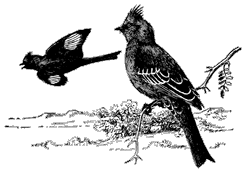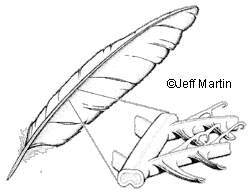Phainopepla
The four species of silky-flycatchers, found mainly in Central America, are not at all related to the true flycatchers; and the main items in their diet are not flies, but berries. In the southwestern United States, the silky-flycatcher known as the Phainopepla is a specialist on the berries of desert mistletoe. Few other birds in North America have such an intimate relationship with a single plant species.

Mistletoe is a parasitic plant, of course, growing on the branches of trees, and it is “planted” there through the actions of birds. When birds eat its berries, the seeds often pass unharmed through their digestive systems; if the birds’ droppings happen to land on a suitable branch, the seeds may stick long enough to germinate. The Phainopepla, by specializing on the berries of desert mistletoe, is unwittingly planting its own future food supply.
In addition to eating mistletoe berries, Phainopeplas eat a variety of other small fruits, and they will fly out to catch insects in mid-air. At times they congregate by the hundreds when food is abundant, such as when elderberries are ripening along rivers at the edge of the desert. When food is scarce, they virtually disappear. Their numbers vary tremendously from season to season. As long as the mistletoe is in fruit, however, there will be at least a few Phainopeplas around. A classic winter sight in the desert is a lone Phainopepla perched atop a mesquite, its spiky crest raised, trim and alert, ready to chase away any other birds that might approach the clumps of mistletoe in the branches below it.
—Kenn KaufmanDistinguishing features
The male is shiny black with a distinct crest, long tail, and red eyes; white patch on the wing is conspicuous in flight. Female and immature birds are gray.
Habitat
This species prefers arid scrub habitats.
Feeding
• Diet: Phainopeplas feed on insects and berries, especially mistletoe, on which it feeds heavily when the berries are ripe. This helps to disperse the mistletoe seed to other host trees.
Life History
This bird nests in early spring in mesquite brushlands, usually well
up in a stout fork or horizontal branch of a tree. The smooth, slightly
glossy eggs usually number 2 to 3 per clutch, and are grayish-white or
pinkish, finely and profusely spotted with black, pale lavender, or gray.
The eggs are incubated by both sexes (possibly the major portion by the
male) for 14 to 15 days. The young are tended by both parents and leave
the nest at 18 to 19 days. ![]()
The Structure of Feathers

The structure of the typical body feather of a bird consists of a central shaft and a web-like vane. The vane is composed of barbs extending laterally from the shaft. Barbules with hooks and flanges project along the length of each barb. The inter- locking hooks and flanges hold the barbs together. If the barbs are pulled apart, they can quickly be re-attached with a smoothing motion. The base of the feather is buried in a follicle beneath the surface of the skin.